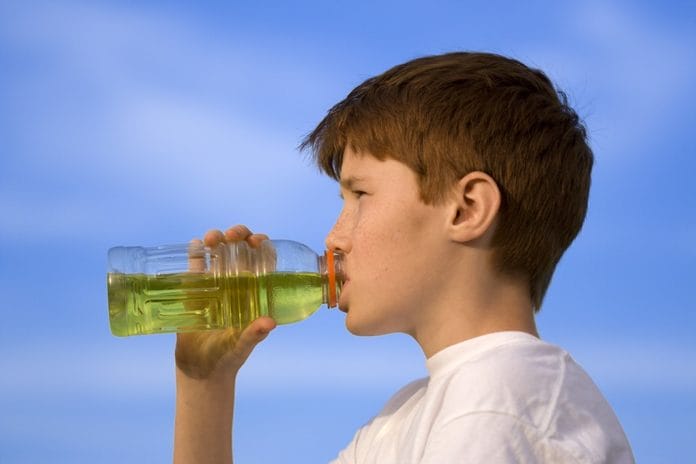A new school year always represents the start of students participating in school sports. The athletic activities typically precipitate an increase in the consumption of sports beverages and protein bars for increasing carbohydrate intake for energy and to replenish electrolytes.
The role of the dental hygienist is to educate the parent and the child on the importance of good nutritional choices. This means avoiding sugary, acidic products such as sports drinks and protein bars.
A study by the University College of London Dental Institute was conducted on 352 athletes about their oral hygiene regimen.1 Although most indicated good oral care habits, the study indicated that 49% of the athletes had untreated decay, and 32% of the athletes’ oral health negatively affected training and performance.1 Furthermore, the majority of the athletes participating in the survey also had early signs of gingival inflammation. The study concluded that the high consumption of sports drinks, protein bars, and energy gels, as well as dry mouth from vigorous activity, all played a role in the negative effects on the athletes’ oral health.3
Tinkering with Salivary Levels
The normal pH level of saliva ranges from 5.6 to 7.9, as described by the International Journal of Drug Testing.2 Saliva not only cleanses the tooth surface but is saturated with calcium and phosphates that prevent acidic demineralization by buffering the acid released by bacteria. Saliva also remineralizes tooth surfaces by providing “glycoproteins that coat the tooth surface as the protective acquired pellicle.”3
Enamel erosion in the oral cavity occurs when the pH ranges from 2.0 – 4.0; demineralization occurs when the pH is less than 5.5. Sports drinks range in pH levels from 2.67 to 7.2. The pH levels of sports drinks indicate high levels of sugar and acid that, in turn, promote demineralization and caries potential.3 Furthermore, a 20-ounce beverage such as a sports drink has 34 grams of sugar, which is one-third the recommended daily intake for a woman.4
Getting the Athlete to Comply
Although the statistical and scientific data is intriguing and alarming, reiterating the information to the dental parent and patient in simplified terms is essential to promoting good nutrition and dental compliance.
First, start the conversation by explaining that dental caries, aka tooth decay, is highly preventable and “the most common chronic disease of children and adolescents ranging in age from six to 19.”5 Second, dental caries cannot occur unless there is an acid introduced to the oral environment.
There are two instances when acid is introduced. The first instance of acid presence is caused by consuming foods or beverages that contain citric acid or have a high acidic content as in the case of fruits. The second instance of acid presence is caused by foods or beverages that are high in sugar, such as sports drinks and protein bars.
Once the sugar is introduced to the oral environment, it is consumed by bacteria, converted to an acid and then deposited on the tooth surface allowing the acid to attack the enamel. The presence of sugar or acid, in turn, lowers the pH level of the mouth, compromising the ability of the saliva to negate the acid. Furthermore, continually consuming acid or sugary products prevents the saliva’s ability to reset its pH, thereby compromising its cavity-prevention effects.
However, reducing the consumption of sugary or acid foods and beverages and increasing water intake, which has a neutral pH of 7.0, will aid in reducing the risk of dental caries.3 The consumption of water will also replenish dry mouth caused by vigorous activity and mouth-breathing, thereby increasing the pH levels of the saliva needed to fight against acid in the oral environment. Topical fluoride use is also important in reducing dental caries; the fluoride binds and remineralizes the enamel surface providing a protective coating from acid.
The importance of understanding caries progression and the factors that contribute to the presence of caries is the key to reducing the disease in our children, adolescents, and adult patients. Furthermore, initiating nutritional guidance to parents, school-age athletes, and any high caries risk child or adult will be beneficial in decreasing caries in the dental population.
Before you leave, check out the Today’s RDH self-study CE courses. All courses are peer-reviewed and non-sponsored to focus solely on high-quality education. Click here now.
Listen to the Today’s RDH Dental Hygiene Podcast Below:
References
- Elite Athletes Have Poor Oral Health Despite Brushing Twice Daily. (2019, August 23). ScienceDaily. https://www.sciencedaily.com/releases/2019/08/190823080012.htm
- Gupta, S. (2019, October 15). What Is pH of saliva? Live Strong. www.livestrong.com/article/192281-what-is-ph-of-saliva
- Reddy, A., Novis, D., Momeni, S.S., Waldo, B. Ruby, J.D. The pH of Beverages in the United States. Journal of the American Dental Association. 2016; 147(4): 255-263. https://www.ncbi.nlm.nih.gov/pubmed/26653863
- Weinberg, S. (2017, May 19). 4 Sports Drinks That Have More Sugar than a Snickers Bar. Delish. https://www.delish.com/kitchen-tools/a53226/four-sports-drinks-with-the-most-sugar/
- Hygiene Related Diseases. (2022, June 15). Centers for Disease Control and Prevention. https://www.cdc.gov/healthywater/hygiene/disease/dental_caries.html










